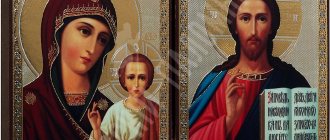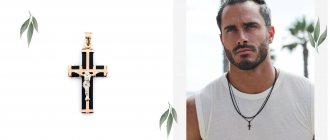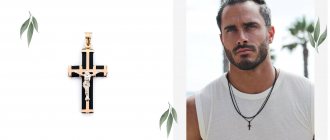The question in the title of the article is common along with another, similar one: is it possible to wear a cross along with an icon. Moreover, people sometimes look for answers far from the church or on Orthodox websites.
But there is nothing surprising in the question itself. Both the icon and the cross are Orthodox symbols. Both protect, help, and inspire confidence. Plus, for many, the cross is a general, abstract symbol.
But specific saints have a reputation for being helpers in a given situation. If you want to resolve problems with housing, this is what you need; if you want to get better, this is what you need.
And when your holy benefactor is nearby all the time, on your neck, you immediately feel calmer.
So is it possible to wear an icon instead of a cross, or with it, from the point of view of Orthodoxy? Let's discuss this and similar questions. But first, let’s figure out why they wear a cross and an icon.
There are no rules for wearing a cross, but it is better for Orthodox Christians to wear it to participate in the life of the church
Moreover, many church rituals cannot be performed without a cross. One can, of course, argue for a long time that there are attributes, but there is a God who doesn’t care about them. He really helps and works wonders without looking at our appearance, clothes and jewelry.
However, there is an Orthodox point of view, a canon, if you will. It was formed over centuries to its current state. The Christian religion is inextricably linked with rites, rituals, and sacraments.
A certain course of action, as is commonly believed, is capable of producing results if it pleases the higher powers.
There is no obligation to wear a cross on the body - it's just a tradition.
To violate this order by self-will and continue to consider oneself Orthodox is strange. Following Orthodoxy implies accepting its traditions. And to dissect religion into what is pleasing and undesirable is already freethinking.
Those who deny rituals can find themselves in some other faith where this is acceptable. For example, in some branch of Protestantism.
Yes, a person does not cease to be Orthodox if he does not wear a cross. And no one has the right to demand to wear it. Orthodoxy is an internal state.
But for some sacraments and services, a cross is simply necessary. Otherwise, they will either not be executed or will be executed incorrectly.
How to choose a cross?
Silver crosses intended for small children must have the inscription “Save and Preserve” engraved on the reverse side. It is also necessary to remember that Catholic and Orthodox crucifixes are somewhat different - among Western Christians, Jesus Christ is crucified with three nails, while in Orthodox iconography he is held on the cross by four.
Traditionally, a cross is worn under clothes - that’s why it is a body amulet, hidden from prying eyes. Therefore, when choosing a chain for it, try to find a product that is long enough.
And, of course, before you buy a silver cross or amulet, you should familiarize yourself with their meaning, symbolism, study the life of a particular saint, and find out the prayers read in front of a specific face. Only then will such an acquisition be soul-saving, edifying and useful, bringing you joy, success, understanding and inspiration!
One cross is needed, but a consecrated one
There are no rules for wearing a cross in Orthodoxy. There are some recommendations. There is a widespread belief that it is better to wear a cross on the body, under clothes.
There is no point in two or more crosses. Is it possible to have several crosses? You can, but there is no point in wearing everything at once. This is an empty action. The benefits of the cross will not increase with such actions.
And if it’s just for show, then instead of crosses you should focus on fighting pride.
It doesn’t matter whether a cross hangs on a chain or braid.
The main thing for a believer is a symbol. Materials and so on mean nothing in matters of faith and relationship with God.
It is better to consecrate the cross. This is how it turns from a piece of jewelry into a sacred object. The fact is that in Orthodoxy there is continuity from the apostles. Each priest ascends through the chain of his predecessors to Jesus Christ himself.
And through this centuries-old heritage, grace actually descends into the object. Therefore, it is better to sanctify than not to do so.
Many priests recommend never taking off the cross once you put it on. This is more practical advice than religious advice. There are no prohibitions or instructions from God in this regard.
Sometimes Orthodox Christians ask, what can they wear instead of a cross? Within the Orthodox tradition, this is a meaningless question. Only the cross is a symbol, a reminder, and protection. Nothing can replace him.
How does Orthodoxy respond to amulets?
During the period of the arrival of Christianity on the territory of Kievan Rus, in order to facilitate changes for the people, Orthodox symbols were crossed with pagan talismans.
Charms came to Orthodoxy from pagan cults, since talismans are based on belief in magical energies and the animation of the elements. In church practice, it is believed that any person who uses the powers of enchanted objects, stones or entities of other religions renounces God and turns to demons. This, according to the rules, results in temporary or permanent expulsion from the church. It is possible to atone for sin, but it takes years. It is incorrect to talk about protection from dark forces with the help of amulets in the context of Orthodoxy, because Christianity assumes that God created the world and filled it with light. By asking to be protected from evil people or curses, a person acknowledges the weakness of the Lord, and also extols demons. The Psalms say that the key to harmony lies in the realization that the baptized and true believers do not need amulets.
The Church believes that in case of any problems, a believer should turn to prayer, and not some kind of amulets.
Although many people believe that body icons and crosses worn around the neck are amulets that protect against evil spirits, diseases and bestow the protection of God, this is not entirely true. The cross and the faces of saints are a reminder of true faith and a sign of devotion. At a moment of weakness, the baptized person should pray and remember that life is a great gift and one should not give up. God already protects everyone, but negative energy does not exist. Pagan Slavic amulets, which supposedly have a positive effect on people's lives, contradict this statement and lead to sin.
The icon (icon) can be worn, but it will not replace the cross
A wide range of swatches are sold today. People call them “icons”. They depict saints, Christ, guardian angels, archangels, etc. This is not an innovation. In Orthodox Rus', such items have existed for a long time.
Our love for saints and Christianity is quite strong, and therefore the desire to carry with us the icon of our beloved saint is very great.
Initially, these were indeed breastplate icons. Some similar items can still be found today - laminated icons the size of a playing card.
They are supposed to be placed in the breast pocket. But over time, images have gained great popularity - they are more aesthetically pleasing, more convenient, and more durable.
There are no rules for wearing the icon.
You can wear an icon just like that, but if you ask for the priest’s blessing for it, it certainly won’t get any worse.
They select the icon to suit themselves - the material to their taste, the face of the saint to whom the heart lies most.
But it is advisable to consecrate the icon in the church.
It also makes sense to purchase such products in specialized church stores or an icon shop. The fact is that the images on the icons must correspond to the canons of icons. Otherwise it's just a picture.
The icon cannot replace the cross
No one can certainly guarantee that wearing the icon will be beneficial. In itself, it makes sense only if a person has sincere faith. Then the icon is a guide to the saint.
An icon is a guide to the saint.
A saint is one who connects a person with the Lord.
Thoughtlessly wearing an icon for show is a waste of time. The Orthodox faith is not magic; everything here is built not on magical objects, but on relationships with the Almighty.
Which icon is better for a woman to wear on her neck, which for a man? Everything here is individual. Don’t think that there are looks that you should and shouldn’t wear. The correct answer is whichever saint your heart lies with, it is better to choose him.
However, most often women prefer the Mother of God, men prefer St. Nicholas or Jesus Christ. They also choose their patrons - those whose name they were given at baptism. But this is not the rule.
Orthodox priests do not recommend wearing an icon instead of a cross. Still, the cross is a tradition, a symbol of faith, emphasizing the sacrifice of Christ, an expression of love for the Lord.
How to wear body icons correctly
Before wearing a body icon around your neck, you need to familiarize yourself with how to choose it correctly. When choosing such a product, pay attention to what it is made of. Popular icons are made of gold or silver. Their main advantage is wear resistance, thanks to which they will last for many years. They are of such high quality that some people pass them on from generation to generation.
Therefore, it is recommended to give preference to products that are made from these alloys.
Each person has the right to independently choose the image on the icon, since there are no strict rules for choosing. However, there are certain traditions that have been followed for many years. For example, images with the Mother of God are more suitable for women. There are many icons depicting the Mother of God. If you wish, you can choose for yourself an icon with the face of the Kazan, Seven-Shot or Vladimir Mother of God. Men are suitable for amulets that depict:
- Jesus Christ;
- St. George the Victorious;
- Nicholas the Wonderworker.
Wearing body icons is quite simple. You just need to hang them around your neck and don’t take them off unless necessary.
A cross and an icon can be worn together, Orthodoxy does not prohibit this
Among believers, there is often a desire to show love for God through various external attributes: you have a cross, you also need an icon. But how to hang them correctly? Is the cross on the same chain as the icon or on different ones?
This is where the study of forums, questions to priests and other search activities begin.
But don't make such a big problem out of it. There are no rules. The Church and God are concerned with much more important issues, such as the salvation of the soul. It is important to remember that wearing a cross and icon is for oneself, and not for God.
He needs only one thing - a person’s pious lifestyle. Therefore, He is not concerned with the nuances of combining Christian symbolism.
The Church and God are concerned with much more important issues, such as the salvation of the soul.
Neither the holy fathers nor the church statutes prohibit wearing a cross and an icon on the same string or chain. Wear it for pleasure. You can use different ones if you want.
But we must not forget that all these objects are made and invented by people. Therefore, in a Christian’s list of thoughts, questions of their combination are far from the first.
But what is really important for an Orthodox Christian is to keep the ten commandments and covenants of Jesus Christ.
The attitude of the church towards body icons
Body icons are considered the most important attribute of the Christian faith. They must accompany a believer throughout his life. It is necessary to put such icons on people from infancy. This amulet will protect him from evil and committing bad deeds. They cannot be removed unless absolutely necessary, since without them a person will remain unprotected.
Most body icons depict images of saints. They are of great importance for every person who sincerely believes in God. You can read about the first body icon in the Bible. It describes one incident from the life of Christ when he healed a sick person with the help of such a sacred image. It was after this incident that Christ’s commandment about icon veneration appeared. Such small body images are no less significant than ordinary icons. They are revered in the Christian church in the same way as wall images of saints.
Is it necessary to wear a cross?
The tradition is many centuries old, but there are no strict responsibilities, only recommendations. Religion is bound by certain rituals, and many sacraments prescribe rules for wearing during their performance. Therefore, it is quite strange to show self-will and come to church without a blessed cross.
If you lose it, you need to go to the priest in church, you will need to take communion, buy a new cross and be sure to consecrate it.
Nothing can replace the cross; it is the symbol of the Christian faith. It cannot be passed on to someone else; this is an individual thing that belongs to a specific person. The only possible case is purchasing as a gift for a close relative or future godson.
Pectoral cross
A pectoral cross is not just a symbol of faith, a symbol of a person’s belonging to the Christian faith, it is the greatest shrine that is given to a person at the moment of his baptism.
We wear a pectoral cross near our hearts, on our chests. We wear it all our lives and often do not take it off under any circumstances. It symbolizes the burden of labor and sins that befell fate. The person wears it on himself, showing his desire for their redemption.
The Bible says:
“...take up your cross and follow Me” (Matthew 16.24)
And it is considered a great sin to wear a cross simply for the sake of fashion, as a tribute to tradition, or as jewelry.
Ladanka
Incense is, first of all, a talisman. Initially, it was a simple bag in which people carried particles of relics, holy land, and prayers. Nowadays, incense boxes are most often made in the form of icons, images of patron saints. And the meaning of the incense has not changed. It is designed to protect and protect its wearer from all sorts of ailments and misfortunes.
The incense, unlike the pectoral cross, is not a mandatory attribute of a believer. To wear it or not to wear it is a personal matter.










